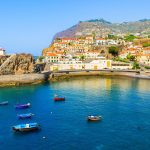Harnessing offshore wind energy — exploring partnerships between Portugal and Ireland
The harnessing of offshore wind energy and the development of partnerships between Ireland and Portugal in this field were discussed and debated at the 2023 edition of the IPBN Ocean Conference which took place at Porto Business School last month.
The Portuguese Government has set itself the ambition of achieving an installed offshore wind energy capacity of 10 GW by 2030 in the national maritime space of the Continent subdivision and achieve the targets set out in the Roadmap for Carbon Neutrality 2050.
Representatives from IberBlue Wind, a joint venture specialising in the design, development, and management of floating offshore wind farms that will operate in the Iberian market, and Enerview Solutions, a leading renewable energy company that provides a robust and bespoke service offering to their clients, specialised in the areas of onshore and offshore wind, solar, and electric vehicle sectors, discussed their projects and challenges on the conference’s second panel moderated by Susan Cabeceiras (Konceptness).
Tiago Morais, the Portugal Floating Wind Development Manager for IPBN and Enterprise Ireland Member company IberBlue Wind explained the company’s ambition to develop projects of 2 GW of offshore wind generated power for the market.
The EU has a target of 60 GW by 2030 and currently has around 28 GW of installed capacity. By 2050 the EU wants to achieve around 300 GW. “This is a huge ambition” he said.
Ireland’s offshore ambitions
Ireland currently has only one small offshore wind farm of 25 MW generated from floated, unfitted structures, while Portugal and Spain together have around 13 MW – together one-third of potential developed projects in Portugal and Spain.
Ireland is now fast-tracking the development of its offshore wind sector in line with its 2019 Climate Action Plan. In May 2020, the Irish government announced project status for seven offshore renewable energy projects. The offshore wind projects have been in varying stages of planning and development in recent years and being granted ‘Relevant Projects’ status will enable fast-tracking to construction and implementation. Ireland’s 2019 Climate Action Plan commits to increasing the country’s offshore wind capacity to 3.5 GW as part of the government’s ambition to deliver 70% of electricity from renewable sources by 2030.
Ireland’s current Relevant Projects under development are: 330-MW Oriel Wind Park led by ESB (Ireland) and Parkwind (Belgium); 600-MW Dublin Array (comprising two projects Kish Banks and Bray Banks) led by Innogy Renewables (Germany); 1-GW Codling Wind Park (comprising two projects, Codling I and Codling II), led by Fred Olsen Renewables (Norway), and EDF (France)
100-MW Skerd Rocks by Fuinneamh Sceirde Teoranta (Ireland).
Portugal’s offshore ambitions
Portugal wants to establish itself as an important player in offshore wind energy and has set a huge ambition for 10 GW of offshore power because it has the available wind resource, and has a large Exclusive Economic Zone (3rd largest in the EU). “We want to share the experience that we have in the two jurisdictions and help make this opportunity a reality,” said Tiago Morais from IberBlue Wind.
Throughout centuries of history, the ocean has played an undeniably central part in the Portuguese economic development, as well as in the construction of its culture and identity. Today, with eyes set on the future, Portugal stands at a turning point, with significant potential offered by a coastline of almost 2,500 Km producing offshore wind energy.
At the beginning of this year, an inter-ministerial working group on offshore wind delineated several areas for commercial projects that would accommodate 10 GW of offshore wind capacity, in line with the plan announced last year.
An ambitious goal
At the end of last month the Portuguese government signalled the opening of an “expression of interest” period for taking part in an auction to award rights for offshore wind energy production with the right to inject electrical capacity into the national grid.
Like in the Ireland case, it is an ambitious goal given that Portugal has only one wind farm at sea – Windfloat Atlantic, located off Viana do Castelo. With innovative characteristics, this is the first floating semi-submersible wind farm in the world, with an installed capacity of 25 megawatts (MW).
The recommendations from the inter-ministerial working group were: Proposal of spatialised areas considering the Allocation Plan for the use of offshore renewable energies; determination of the connection points of the new maritime wind farms with the Nacional Energy Transport Net;
creation of a model for the attribution of Capacity Reservation Titles, and an assessment of the requirements for the development of port infrastructures associated with these projects.
In this regard, the workgroup has recently submitted to public consultation a preliminary proposal to delimit the areas of implantation of offshore wind farms. Viana do Castelo, Leixões, Figueira da Foz, Ericeira, Sintra/Cascais, and Sines are being considered.
Tiago Morais of IberBlue Wind wants his company to be part of the solutions to the Portuguese government’s ambitious target, potentially in partnerships with others such as
“We are creating value, jobs and sharing knowledge in the markets in which we’re operating and having an impact on industry”, he added.
Morais has worked for more than 17 years on projects related to the sea and holds a Master’s degree in Electrical and Computer Engineering with a specialisation in power systems and renewable energies from the Faculty of Engineering of the University of Porto (FEUP).
His wealth of experience managing and developing innovation and research projects has led him to coordinate and participate in a significant number of projects with partners from the industry and scientific field at both national and European levels.
Tiago also has expert knowledge in the IMTA aquaculture sector, underwater robotics, oil and gas industry, offshore wind and marine renewable energies.
His work has been published over the years in several national and international strategic documents and scientific journals with high impact value.
Plan-led approaches
In a recent chat with the IPBN, Tiago had shared his impressions of the synergies in the incentives between Ireland and Portugal in relation to the European Green Deal.
“I believe that the Governments of both Portugal and Ireland are fully committed to making this ambition a reality, with a view to an energy transition that is intended to be sustainable”, he said.
In Ireland, there has been a change in policy to a plan-led approach, which has had a significant impact on the pace of development of projects, and has had implications for supply chain and investor confidence, and may have implications on the 2030 targets,” he added.
He pointed out efforts made by both governments in Portugal and Ireland in defining the status plans for maritime spatial planning and specific tender procedures, which include the definitions of the price for the sale of electrical energy to the grid, connection points to the electrical grid, and the form of allocating maritime areas so that it is possible, within a competitive process, for developers, to have the necessary tools to develop their projects.
Synergetic partnerships
Further driving the conversation was Gavin McBride, Managing Director at IPBN Member company Enerview Solutions.
Gavin is responsible for the development of large-scale onshore projects throughout Europe and Africa which involves the ability to work in both formal and informal settings with all stakeholders. His management experience includes several multi-million euro Projects with the erection of over 600 turbines.
“Portugal was a natural choice for Enerview Solutions because the network is incredible and because Portugal had gained so much knowledge in such a small space of time. We hope to engage with companies and provide knowledge from our experience and share knowledge through synergies and transition that through partnerships.”
Tiago Morais (IberBlue Wind explained that there needed to be an understanding of the synergies in relation to the ports and the relation with industry, as well as the wind. “There are a number of factors that we need to analyse the best place to develop and design our projects.
“Today we are much better informed about the Portuguese government’s plans because in the space of one year the government has set the ambition to achieve 10 GW of offshore wind power out of a possible 100 GW of offshore potential in Portugal, yet only 10 GW so far have been considered.
The CREOULA Project
Earlier this year, the Portuguese town of Viana do Castelo hosted a conference called “Floating offshore wind energy in the Northern region of Portugal – ‘CREOULA Project’, a meeting promoted by IberBlue Wind.
This meeting aimed to analyse the opportunities offered by offshore wind energy in the region, publicise its proposal on this matter, as well as explaining the ‘CREOULA’ floating offshore wind development that IberBlue Wind is proposing in the region.
IberBlue Wind presented ‘CREOULA’, the largest floating wind farm projected in Portugal that will have a capacity of 1,440 MW, produced from 80 turbines of 18 MW each. A project that, together with the Juan Sebastián Elcano project – located off the coast of Pontevedra (Galicia) – forms part of the first cross-border development in southern Europe and together will offer a proposed capacity of 1.96 GW.
IberBlue Wind is exploring the opportunities that the production of offshore wind energy represents in the Portuguese energy transition, underlining its driving role in the socioeconomic revitalisation of the areas of influence, due to its capacity for generation of employment and the necessary improvement of the infrastructures that this entails.
IberBlue Wind, he said, is committed “to working together with civil society, coastal communities, government and industry, with the aim of benefiting the region, and most importantly always respecting the environment” and “establishing a collaboration channel with the industrial and business networks in the area and to spot opportunities and align interests.”
“Portugal has set the ambition, defined the areas where these projects can be developed and their economic impact on these areas and communities, the ports and investments in the ports, the grid entry facilities, and possible tariffs for the energy that can be sold on the grid”, said Tiago Morais.
“We also know that the Portuguese government wants to hold the first auction this year and is making a lot of effort to making this ambition a reality but there are challenges”, he warned.
These “huge challenges” include the regulatory framework where and how the “rules of the game” are defined, the supply chain – which means not just the supply chain available in Portugal, but also overseas because the potential for developing floating offshore projects is no only in Portugal, but all over Europe) “We have set ambitions to have projects in operation by 2030 which are very high, and the supply chain has to be prepared to meet these challenges,” concluded Tiago Morais of IberBlue Wind.










